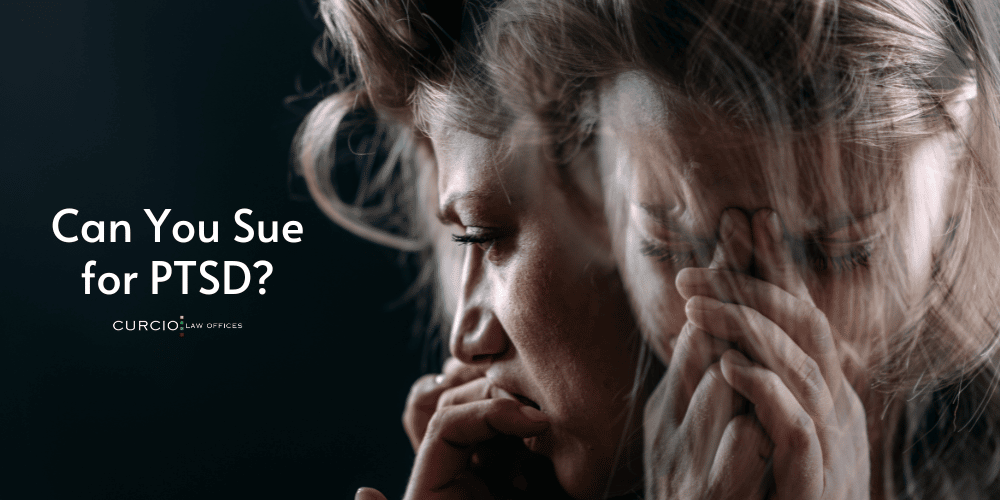Thousands of Americans suffer from the debilitating symptoms of post-traumatic stress disorder (PTSD) every year. Unfortunately, many cases of psychological and emotional trauma are caused by someone else’s negligent actions or inactions. For example, a texting driver crashes into a responsible driver and causes them major physical and emotional trauma. Or a careless surgeon makes a major mistake in the operating room, causing the patient to suffer from months of physical and emotional distress. Maybe you have endured a situation like this and you’re wondering: can you sue for PTSD? The short answer is yes, and the good news is that a Chicago emotional distress lawyer can help.
The top-notch legal team at Curcio & Casciato has what it takes to successfully litigate emotional distress claims. Call us today at 312-321-1111 to schedule a free consultation.
What is PTSD?
Post traumatic stress disorder (PTSD) is a psychological disorder that often develops after someone has endured or witnessed a traumatic event. Even if the victim doesn’t suffer any physical harm during the traumatizing event, the fear and mental pain can certainly follow the victim for the rest of their lives. Without proper treatment and support, a victim’s emotional distress from PTSD can be life-threatening.
PTSD Symptoms
PTSD symptoms fall into four main categories: reliving, avoiding, increased arousal, and negative cognitions and mood.
- Reliving: PTSD victims often relive their trauma for years after the original event through nightmares, flashbacks, intrusive memories, hallucinations, and more. Additionally, a victim may feel as though they’re reliving their trauma on anniversary dates and whenever they encounter specific triggers.
- Avoiding: People with PTSD will actively try to avoid anything that reminds them of their trauma. This can be people, places, situations, sights, smells, sounds, etc. Additionally, PTSD sufferers may withdraw from their loved ones and enjoyable activities due to their daily psychological or mental pain.
- Increased Arousal: PTSD sufferers generally experience increased physical and mental arousal. This means that they may jump at the most minor sight or sound. They may also have sudden mood swings and outbursts. The physical manifestation of emotional pain generally falls under this category of symptoms. For example, intense mental distress can cause physical symptoms such as gastrointestinal problems, elevated heart rate, high blood pressure, tense muscles, rapid breathing, and difficulty staying asleep.
- Negative Cognitions and Mood: The PTSD sufferer will generally struggle with feeling happy and at peace. They may experience intense sadness, hopelessness, anger, anxiety, panic, low self esteem, guilt, shame, and more.
Other common PTSD symptoms include frequent panic attacks, uncontrollable crying, substance abuse, self-harm, suicidal thoughts and behaviors, memory loss, difficulty concentrating, etc. In general, the PTSD sufferer will struggle to care for themselves or function in their day to day life following the traumatic event.
Common Causes of PTSD
PTSD is generally caused by enduring or witnessing one of the following events:
- Sexual abuse and sexual assault
- A serious accident such as a car accident, an 18 wheeler accident, a pedestrian accident, a bicycle accident, etc.
- A medical malpractice incident such as a surgical error, a birth injury, a medication error, etc.
- Experiencing a life-threatening health crisis
- Violent attacks, such as shootings or beatings, which may or may not result in physical injuries
- Enduring threats of physical injury
- Poverty
- Verbal attacks and/or psychological manipulation
- Childhood abuse or neglect
- Natural disasters
- War
- Terrorism
If you suffered immense mental anguish due to someone else’s negligence, our Chicago legal team may be able to help you pursue justice through an emotional distress lawsuit. Our personal injury attorneys have what it takes to successfully litigate negligence-based issues such as motor vehicle accidents, medical malpractice incidents, and even the negligent or intentional infliction of emotional distress.
Risk Factors for Developing PTSD
Anyone of any age can develop PTSD. However, some people may be more at risk of suffering from severe emotional distress than others. Experts believe that the following risk factors may raise your chances of developing PTSD:
- Enduring or witnessing traumatic events for a long period of time.
- Previously enduring some form of childhood trauma.
- Having other types of mental illness such as anxiety, depression, panic disorder, OCD, etc.
- Having a family history of mental suffering.
- Abusing alcohol and/or drugs on a regular basis.
- Not having close friends or family who are willing to provide support.
- Working in the healthcare industry or the military, because lots of physical and mental trauma occurs in these fields.
- Being a woman.

How Many Americans Have PTSD?
According to the American Psychiatric Association (APA), approximately 3.5% of U.S. adults suffer from PTSD on an annual basis. The APA also predicts that 1 out of every 11 Americans will receive a PTSD diagnosis in their lifetime. Lastly, women are more likely to receive a PTSD diagnosis than men.
PTSD Treatments
The best treatment for PTSD is a combination of psychiatric medications and therapy. There is a wide variety of antidepressants and anti-anxiety medications out there, and figuring out which one will work for you is often a process of “trial and error.”
The same goes for different types of therapy. Some types of therapy will work really well for some people with intense emotional distress. Meanwhile, other types of therapy won’t provide much relief. Types of therapy that can provide relief to PTSD sufferers include Cognitive Behavioral Therapy (CBT), Cognitive Processing Therapy (CPT), and Eye Movement Desensitization and Reprocessing (EMDR) therapy.
Can You Sue for PTSD?
Now back to the main question at hand: can you sue for PTSD?
The answer is yes, especially if your PTSD was directly caused by someone else’s negligence. For example, if a drunk driver or a negligent doctor caused you to suffer severe emotional distress, an experienced personal injury lawyer at Curcio & Casciato can help you recover damages through an emotional distress claim. You may also be able to sue for negligent and intentional infliction of emotional distress (IIED), depending on the facts of your case.
Emotional Distress Claim vs. IIED Claim
Negligent or intentional infliction of emotional distress (IIED) occurs when someone commits a horrific or outrageous act with the intent of causing psychological and emotional trauma upon the victim. The negligent infliction of emotional distress could include threatening future harm upon the victim, for example.
In order to sue for the intentional infliction of emotional distress, the case must meet this criteria:
- The defendant’s conduct must have been outrageous and/or horrific,
- The defendant must have had the intention to cause severe emotional distress upon the victim,
- And the defendant must have directly caused severe emotional harm upon the victim.
It is more common to sue for emotional distress rather than to sue for the negligent infliction of emotional distress. The two claims are very different, with the latter being much more complicated and difficult to prove.
Most emotional distress claims are connected to some kind of serious injury, such as a traumatic brain injury or a spinal cord injury, for example. Meanwhile, the negligent infliction of emotional distress doesn’t usually involve a personal injury. These types of cases generally involve threats, harassment, gaslighting, psychological manipulation, and/or performing violent acts on another person in front of the victim. Naturally, both types of cases involve PTSD victims.
Whether you’re suing for emotional distress or for IIED, the legal team at Curcio & Casciato can help.
Proving Emotional Distress
It’s much more difficult to prove emotional distress than it is to prove a common personal injury such as a traumatic brain injury. That’s because mental and emotional injuries are generally invisible. But that doesn’t mean they’re any less serious.
The following elements generally must be proven in emotional distress lawsuits:
- Duration of the Emotional Distress: In order to have a strong claim, you must be able to show that your emotional distress has been going on for a long time following your traumatic accident or event.
- Severity of Emotional Distress: A certain level of emotional distress is normal after any traumatic accident or event. However, the strongest emotional distress claims highlight the victim’s inability to function on a daily basis due to the trauma they have suffered. Maybe the victim requires intensive therapy and medication to even step outside of their house. Maybe the victim cannot eat due to their severe mental suffering, which has naturally led to other health problems.
- Severity of the Traumatic Accident/Event: Suing for emotional distress following a minor fender bender probably won’t be a successful case. However, suing for emotional distress after a major car accident may result in justice and a fair settlement.
Strong emotional distress evidence can include medical records, witness statements from loved ones, and expert witness statements from doctors/psychologists.
Emotional Distress Damages
Emotional distress and pain and suffering damages are very common in personal injury claims. These types of emotional damages generally fall under a category called “non-economic damages” because it’s nearly impossible to measure them monetarily.
If you decide to just file an emotional distress claim, and not a personal injury claim – you could recover compensation for the following types of damages:
- Past and future medical bills from psych ward hospitalizations and psychiatric medications
- Past and future mental health counseling expenses
- Lost wages if your PTSD prevents you from going to work
- Loss of earning capacity if your PTSD prevents you from accomplishing the same job duties as prior to the traumatic accident
- Loss of enjoyment of life
- Loss of consortium if your PTSD creates significant marital strain

Call a Chicago Emotional Distress Lawyer at Curcio & Casciato Today
If you have suffered emotional distress and/or PTSD from someone else’s negligent actions or inactions, then you may have grounds to sue for emotional distress. Suing for emotional distress can certainly be more difficult and complicated than suing for a physical injury. That’s why it’s so important to hire an experienced legal team with extensive knowledge of personal injury law. The team at Curcio & Casciato understands that while PTSD is often an “invisible injury,” it’s just as debilitating as many other physical injuries. We have what it takes to successfully litigate your case and help you recover emotional distress damages. Call 312-321-1111 to schedule a free consultation with a Chicago emotional distress lawyer today.



